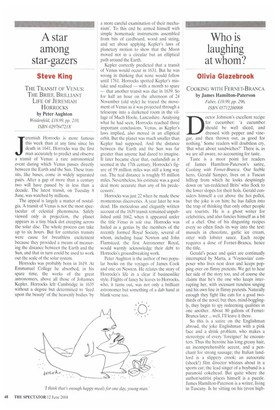A star among star-gazers
Steve King
THE TRANSIT OF VENUS: THE BRIEF, BRILLIANT LIFE OF JEREMIAH HORROCKS by Peter Aughton Weidenfeld, £18.99, pp. 210, ISBN 029784721X tireremiah Horrocks is more famous this week than at any time since his death in 1641. Horrocks was the first man accurately to predict and observe a transit of Venus: a rare astronomical event during which Venus passes directly between the Earth and the Sun. These transits, like buses, come in widely separated pairs. After a gap of more than a century two will have passed by in less than a decade. The latest transit, on Tuesday 8 June, was watched by millions.
The appeal is largely a matter of nostalgia. A transit of Venus is not the most spectacular of celestial phenomena. Safely viewed only in projection, the planet appears as a tiny black dot creeping across the solar disc. The whole process can take up to six hours. But for centuries transits were cause for breathless excitement because they provided a means of measuring the distance between the Earth and the Sun, and that in turn could be used to work out the scale of the solar system.
Horrocks was probably born in 1619. At Emmanuel College he absorbed, in his spare time, the works of the great astronomers, above all those of Johannes Kepler. Horrocks left Cambridge in 1635 without a degree but determined to 'feed upon the beauty' of the heavenly bodies 'by a more careful examination of their mechanism'. To this end he armed himself with simple homemade instruments assembled from bits of cardboard, wood and string, and set about applying Kepler's laws of planetary motion to show that the Moon moved not in a circular but an elliptical path around the Earth.
Kepler correctly predicted that a transit of Venus would occur in 1631. But he was wrong in thinking that none would follow until 1761. Horrocks spotted Kepler's mistake and realised — with a month to spare — that another transit was due in 1639. So for half an hour on the afternoon of 24 November (old style) he traced the movement of Venus as it was projected through a telescope into a darkened room in the village of Much Hoole, Lancashire. Analysing what he had seen, Horrocks reached three important conclusions. Venus, as Kepler's laws implied, also moved in an elliptical orbit. But the planet was much smaller than Kepler had supposed. And the distance between the Earth and the Sun was far greater than anyone had dared to imagine. It later became clear that, outlandish as it seemed in the 17th century, Horrocks's figure of 59 million miles was still a long way out. The real distance is roughly 93 million miles. Nevertheless, his estimate was a good deal more accurate than any of his predecessors'.
Horrocks was just 22 when he made these momentous discoveries. A year later he was dead. His meticulous and elegantly written account of the 1639 transit remained unpublished until 1662, when it appeared under the title Venus in sole visa. Horrocks was hailed as a genius by the members of the recently formed Royal Society, several of whom, including Isaac Newton and John Flamsteed, the first Astronomer Royal, would warmly acknowledge their debt to Horrocks's groundbreaking work.
Peter Aughton is the author of two popular books on the voyages of James Cook and one on Newton. He relates the story of Horrocks's life in a clear if businesslike style. Flights of fancy he leaves to Horrocks, who, it turns out, was not only a brilliant astronomer but something of a dab hand at blank verse too.


















































































 Previous page
Previous page